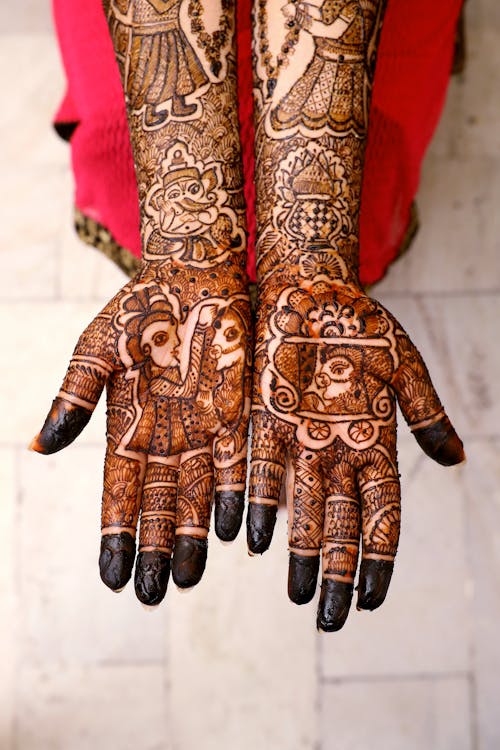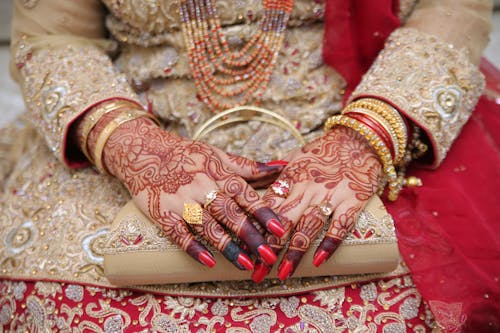
Henna Tattoo: Beauty and Knowledge
You may have seen a henna tattoo in passing, or have a friend who got one on vacation, but how much do you really know about henna tattoos?
In another part of the world, henna tattoos have a deeper meaning than cool body art to post on Instagram. It is deeply ingrained in Indian culture and plays an integral part in religious ceremonies and other celebrations.
Before you get your henna tattoo, take a moment to acknowledge and understand where it comes from. This way, you’ll have a greater appreciation of the art and can even share the beauty and knowledge with your friends!
What is Henna and how is it made?

Henna, is actually a paste made from henna leaves. While it is also known as Mehndi, henna is the paste used and Mehndi is the act of applying the paste. Henna paste has been used by several cultures from the beginning of time for cultural and cosmetic purposes.
Mehndi is especially popular in Indian and African cultures. There is also wide usage of henna in places such as Somalia, Algeria, Morocco, Yemen, Turkey, Bulgaria, and Afghanistan.
The leaves are dried, and crushed into a fine powder that is then sifted and stored for later use. When it's time to make the paste, the powder is mixed with a liquid such as lemon juice, herbal tea, or water.
This mixture is made to sit for around 48 hours so that the lawsone molecules (the agent responsible for staining the skin) have time to develop properly. At this point, essential oils may be added to increase its strength.
When the paste is ready, it is usually applied with a stick, syringe, plastic cone, or piping bag. In just a few minutes, it will leave a light stain on the skin. When left for a few hours or even overnight, the stain will become darker and more prominent.
During this time, no water comes in contact with the paste, even after it is scraped off. The henna oxidizes and changes from orange to a deep reddish-brown within a week. The skin is then stained with the design for up to 3 weeks in some cases.
In Egypt and parts of Europe, henna was prized as a hair dye to make hair a deep red color. In the Middle East, Muslim men use it to dye their beards, and women are encouraged to dye their fingernails and toenails to emphasize their femininity.
Is getting a henna tattoo considered cultural appropriation?

If you’ve seen the term ‘cultural appropriation’ getting thrown around in online arguments and debates, then you may have an idea of what it means. If not, simply put, it’s when someone from a culture takes something from another culture to use for personal gain.
Take kimonos for example. They are traditionally worn by Japanese men and women during weddings, funerals, festivals, and other special occasions. Nowadays, fashion designers and other people wear them for fun with no regard or recognition for Japanese culture. Many Japanese people find this practice offensive.
Getting a henna tattoo may be seen as cultural appropriation if one does not take the time to educate themselves about the practice. Mehndi is a part of the cultural identity of many people and to take from their culture without acknowledging that fact is disrespectful and rude.
If you have taken the time out to learn about henna, beyond the body art, and gain a deeper appreciation of the practise you can get a henna tattoo, preferably from a person who has roots in the culture. You would be doing something that may instead be seen as cultural appreciation. If you are still iffy about it, reach out to someone within the culture. If you do not know anyone in your local area, try DMing someone online to learn more.
How are henna tattoos different from regular tattoos?
Henna tattoos are not the same as regular tattoos. The only real similarity is that they are applied to the skin, but other than that they are completely different.
Application
While they are both applied to the skin, they are applied to different layers and in different ways.
A henna can be applied with pretty much anything it can stick to and be used to draw with, or anything it can be squeezed out of. It is applied to the top layer of the skin and does not involved needles or blood. Henna tattoos can be applied in any environment and are commonly done right in your livingroom.
A tattoo is applied with special needles that pierce the skin and insert ink into the second layer of the skin called the dermis.Tattoos need to be performed in the sterile environment of a tattoo studio by a trained professional. If you are thinking about becoming a tattoo artist and want to expand your drawing skills, our Ultimate Needle Set brush set for Procreate has everything you need to refine your drawing skills.
Detail and Design
While there are many very detailed henna designs out there, there is greater flexibility and variation when it comes to regular tattoos.
For starters, henna does not come in a wide range of colors and most times designs are pretty uniform and flat. Tattoos, on the other hand, can involve many colors and shading techniques. Tattoo needles are also a lot thinner than even the smallest henna applicator.
Longevity
A henna tattoo does not last very long and can begin to fade in as little as a week. It is a temporary stain that is removed as the skin exfoliates.
A tattoo is permanent and lasts for many years unless it is purposefully removed, using a laser tattoo removal machine. It may fade but the majority of the ink remains in place.
Pain
Getting a henna tattoo should not be painful at all. It should feel sort of like glue or paint is being applied to the skin. This is usually a gentle and calming process. The only time pain may occur is if you are allergic to the henna - a patch test is always recommended before getting a henna tattoo.
A tattoo is notoriously painful because the needles penetrate the skin for an extended period of time, depending on how large and detailed the tattoo is. The artist essentially creates an open wound which naturally will be painful. Here are some tips on how to reduce the pain of getting a tattoo.
Removal
A henna tattoo may be easily removed with simple soap and water over the course of a few days.
A tattoo is removed using a laser. This usually takes multiple sessions and can be very expensive and paiunful, and may leave scarring.
Where can I get a henna tattoo?

Getting a henna tattoo is pretty easy. DIY kits are available online and there are many YouTube videos on how to apply it yourself.
Many people, especially of Indian descent, offer henna tattoos as a service and can easily be found with a quick Google search. Just type in “Henna tattoo in [insert your town/city]”.
Henna tattoo booths are common at concerts, fairgrounds, and other mass gatherings and events. Some tattoo artists also offer henna tattoos in addition to regular tattoos and piercings.
Are there any health risks?

Like everything in life, henna tattoos do carry its own set of health risks. However, it is generally safe and most people have them done without any adverse reactions.
Though uncommon, henna may cause allergic reactions, usually due to other ingredients in the paste such as lime juice, herbal tea, or essential oils. These symptoms include redness, blistering, increased sensitivity to sunlight, and on rare occasions permanent scarring.
Henna is especially dangerous for people with glucose-6-phosphate dehydrogenase deficiency, or G6DP deficiency. This is a very rare genetic condition more commonly observed in males of African, Sephardic Jewish, Greek, Italian, and Arabic ancestry. In this case, the body does not have enough of a special enzyme that helps red blood cells to carry out their functions. Henna tattoos may trigger this condition and cause a rapid breakdown in red blood cells.
The FDA has not given henna the green light to be used as a skin dye, however, it has gotten the all-clear for use as hair dye. It is important to note that not all packages labeled “henna” are actual henna. A good way to tell is by their color. Natural henna is brown, orange, or red. Henna does not come in colors such as yellow, green, purple, red, blue, and so forth.
Summary

Henna tattoos are perfect for people who are too scared to get a real tattoo. They are also a great stepping stone for people who are indecisive.
- The use of Henna originated in areas of the world such as India, the Middle East, and Northern Africa.
- Henna tattoos are temporary stains on the skin from using henna, called Mehndi. Getting a henna tattoo is pretty easy, and a quick Google search should reveal artists in your area who specialize in henna tattoos.
- Henna tattoos are not the same as regular tattoos and differ in many ways including their application, detail and design, longevity, pain, and removal.
- Adverse health reactions to henna tattoos are not common, but its ingredients have been known to cause allergic reactions such as blistering, redness, and irritation. Henna is also dangerous for persons with G6DP deficiency.
Stay connected with news and updates!
Join our mailing list to receive the latest news and updates from our team.
Don't worry, your information will not be shared.
We hate SPAM. We will never sell your information, for any reason.



